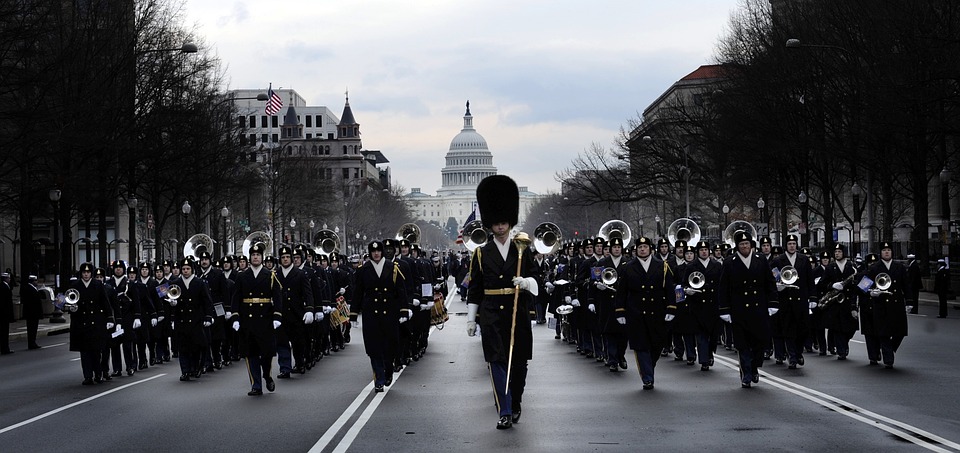Have you ever organized a large event with a lot of out-of-town guests? Imagine organizing President-Elect Trump’s inauguration. Here is some information and insight into how this momentous quadrennial event unfolds.
Inauguration by the Numbers:
- The Presidential Inauguration Committee (PIC) allots 240,000 free tickets to House and Senate offices, which they distribute on request, mostly to constituents. However anyone can watch the swearing-in ceremony from the National Mall in Washington DC for free.
- George Washington gave the shortest inaugural address, 135 words, in 1793, and William Henry Harrison the longest, 8,460 words, in 1841. Modern addresses tend to be well under 3,000 words.
- The city of Washington DC provides funds for many inauguration expenses, which the federal government later reimburses. “The city spent $18.2 million on the 2013 presidential inauguration. Congress has already appropriated nearly $20 million to cover the city’s 2017 inauguration.”
- Many Washingtonians rent out their homes and leave the city for the weekend to escape the traffic and influx of tourists.
- There will be a predicted $1.4 billion boost to the D.C. economy because of the tourists visiting for the inauguration. The new Trump International Hotel in D.C. is already sold out.”
- Attendance for past inaugurations has ranged from several hundred thousand to over 1 million. An estimated 800,000 people will attend Trump’s inauguration.
Who Organizes the Inauguration Ceremony & Festivities?
The main groups responsible for the infrastructure, planning, logistics, and programming are the Joint Congressional Committee on Inaugural Ceremonies (JCCIC), made up of Congressional leaders, and the Presidential Inaugural Committee (PIC), generally managed by the president-elect’s campaign and transition members and staff.
Since 1901 the JCCIC has planned and carried out the swearing-in ceremonies and inaugural luncheon at the Capitol. The JCIC also constructs the inaugural platform from scratch for each ceremony. Planning and design of this infrastructure begins more than a year in advance, and the physical construction begins several months before inauguration. This year the traditional “first nail” ceremony was held in September.
PIC organizes the inaugural welcome celebration with performers, the traditional wreath-laying ceremony at Arlington National Cemetery, the inaugural parade, and the inaugural balls.
Security Concerns
Security is coordinated by a Joint Task Force made up of U.S. military members, the National Guard, the U.S. Capitol Police and law enforcement officers from around the country. Together they coordinate with the FBI and other intelligence agencies to provide security for the inaugural weekend.
The 58th Presidential Inauguration: Fun Facts
- The inaugural platform will be over 10,000 square feet and will hold more than 1,600 people.
- Trump’s campaign slogan “Make America Great Again” will also be the theme of the inauguration.
- The formal transition of power occurs at noon on Friday, January 20th, followed by the inaugural parade.
- It’s tradition for the outgoing president to accompany the new president to the Capitol and for past presidents to attend the ceremony.
- Inauguration Day concludes with the Inaugural Ball that evening. The number of Inaugural Balls has grown over time, with Obama attending 10 and George W. Bush attending 8, but Trump’s administration will be reducing the number of official balls.
- Many informal galas and parties will still occur – embassies, organizations and most states hold their own breakfast, lunch, balls and celebrations. Think the holiday party season crammed into 3 days.
- According to the Washington Post, “Officials say they are anticipating a larger-than-usual number of protesters this inauguration but are unsure of exactly what to expect as they converge with Trump supporters at the inaugural ceremony at the U.S. Capitol, the parade that will follow and several planned demonstrations.”
If you’re not in the D.C. area, you can watch the broadcast of the swearing-in ceremony live on major news networks.
Do you plan to tune in or put on your ball gown?
It’s a movement!
Recommend a Circle Leader. Circles are starting in DC, in Wisconsin, Minnesota, Arizona, and New York where circles are sprouting.
Start a Circle in your neighborhood. Add value in your community by giving women the facts and the space to strengthen their understanding of the issues.
Invest in The Policy Circle. Together let’s build a network of women who want to assume their civic duties and understand the impact of policy in their lives.
The Policy Circle is a 501(c)3 that provides a fact-based, nonpartisan framework that inspires women living in the same community to connect, learn about and discuss public policies that impact their lives. Women across the nation are taking a leadership role in public policy dialogue on what human creativity can accomplish in a free market economy.
